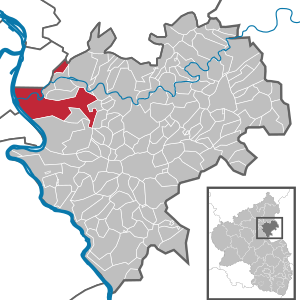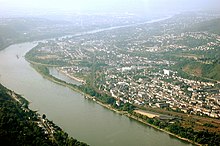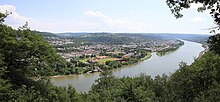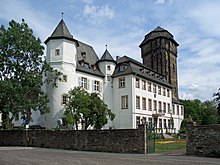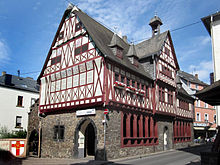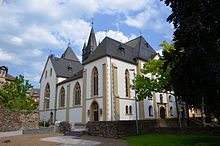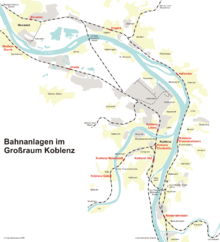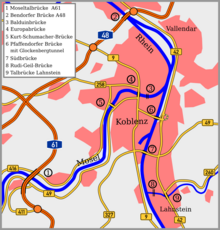Lahnstein
| coat of arms | Germany map | |
|---|---|---|

|
Coordinates: 50 ° 18 ' N , 7 ° 36' E |
|
| Basic data | ||
| State : | Rhineland-Palatinate | |
| County : | Rhein-Lahn district | |
| Height : | 74 m above sea level NHN | |
| Area : | 37.56 km 2 | |
| Residents: | 18,042 (Dec. 31, 2019) | |
| Population density : | 480 inhabitants per km 2 | |
| Postal code : | 56112 | |
| Area code : | 02621 | |
| License plate : | EMS, DIZ, GOH | |
| Community key : | 07 1 41 075 | |
| City structure: | two districts | |
City administration address : |
Kirchstrasse 1 56112 Lahnstein |
|
| Website : | ||
| Lord Mayor : | Peter Labonte ( CDU ) | |
| Location of the city of Lahnstein in the Rhein-Lahn district | ||
Lahnstein is a large city in the Rhein-Lahn district in Rhineland-Palatinate . It lies at the mouth of the Lahn , which flows into the Rhine five kilometers south of Koblenz . The districts are located in the Rhine Valley and on the heights of the foothills of the Westerwald and Taunus . Lahnstein is a climatic health resort with a spa center and thermal baths. On June 7, 1969, the city was formed from the previously independent cities of Niederlahnstein and Oberlahnstein . It is the seat of a local court . Parts of the city have been part of the Upper Middle Rhine Valley UNESCO World Heritage Site since 2002 . Ecclesiastically it is assigned to the diocese of Limburg (Roman Catholic) and the Protestant church in Hesse and Nassau .
geography
climate
The annual precipitation is 673 mm. The precipitation is in the middle third of the values recorded in Germany. Lower values are registered at 34% of the measuring stations of the German Weather Service . The driest month is February, with the most rainfall in June. In June there is 2.1 times more rainfall than in February. The rainfall varies moderately. Lower seasonal fluctuations are recorded at 47% of the measuring stations .
City structure
The town of Lahnstein consists of the two districts Oberlahnstein and Niederlahnstein; Oberlahnstein includes a total of 24 (including Friedrichssegen, Friedland, Lahnstein auf der Höhe, St. Martin settlement), and Niederlahnstein a further five parts of the municipality (including Allerheiligenberg, Im Lag, Auf Ahl).
history
The Romans built a castle at the mouth of the Lahn in today's Niederlahnstein in 369 , which served as a border fortification and was a kind of guard post for the Fort Confluentes (today Koblenz ). The Lohenstein House, built on the remains of the Burgus, fell to Kurtrier in 1018, and the late Romanesque Johanniskirche was built on the same site in the 12th century . In Oberlahnstein , the Franconian Salhof came to Kurmainz around 900 .
Since 1226 the Archbishop of Mainz Siegfried III. von Eppstein Burg Lahneck to protect its area at the mouth of the Lahn, where the town of Oberlahnstein and the silver mine, which had been in Friedrichssegen since 1220, came to Kurmainz. The first mention of a burgrave at the castle was in 1245. The Archbishop of Trier Arnold II of Isenburg acquired the bailiwick of Niederlahnstein in 1256. The Martinsburg was built at the end of the 13th century as a base for exercising the Mainz customs rights on the Rhine.
King Ludwig IV the Bavarian granted Oberlahnstein town charter in 1324 , and construction of the town fortifications began at the same time. Niederlahnstein received city rights in 1332, but they had no effect. A customs tower in Trier was built on the Lahn in 1348, which has been preserved on the inn on the Lahn built in 1697 . The St. Barbara Chapel was built in Niederlahnstein in 1358. During the Mainz collegiate feud in 1461/1462, Lahneck and Oberlahnstein Castle fell temporarily to Kurtrier, after Koblenz and Trier troops attacked Oberlahnstein in 1462.
The old town hall of Oberlahnstein was first mentioned in 1507. The plague broke out in Lahnstein in 1542. In 1569 a ferry line was built across the Lahn between Oberstein and Niederlahnstein. During the Thirty Years War , both parts of the city were occupied several times by Swedish, Imperial, French and Hessian troops. A first Allerheiligenberg chapel was built in 1671, the neo-Gothic successor building in 1895–1901. In the Palatinate War of Succession in 1688, Lahneck Castle was destroyed by French troops by setting the roofs on fire. Goethe , accompanied by Lavater and Basedow , docked in Lahnstein on July 18, 1774 on a boat trip on the Lahn and Rhine and had his lunch in the tavern on the Lahn.
During the coalition wars Ober- and Niederlahnstein were alternately occupied by Austrian, Prussian, French and Russian troops between 1795 and 1800. After the French had withdrawn from the right bank of the Rhine in the Peace of Lunéville , Lahnstein first fell to Nassau-Usingen through the Reichsdeputationshauptschluss of 1803 and then to the newly created Duchy of Nassau in 1806 . In 1852 the reconstruction of Lahneck Castle began. A first section of the Lahn Valley Railway from Oberlahnstein to Bad Ems was opened on July 1, 1858. On August 11, 1856, the first section of the Nassau Rheinbahn from Wiesbaden to Rüdesheim was opened. Because of the difficult construction work, the line was only extended to Oberlahnstein on February 22, 1862 and to Niederlahnstein on June 3, 1864, after the first railway bridge had been built over the Lahn in 1862.
After the Duchy of Nassau lost the German War on Austria's side in 1866 , it was annexed by Prussia . The now Prussian Lahnstein began work to connect its railway to the Prussian right-wing Rhine route by 1869 . Since 1873 a road bridge over the Lahn has connected the present-day districts of Ober- and Niederlahnstein. The bridge, which was last replaced by a new building in 1997, was named Rudi-Geil-Brücke in 2008 after the Lahnstein politician Rudi Geil . In 1902 Niederlahnstein was connected to the Koblenz tram. Between 1910 and 1912 Theodor Zais developed the Ruppertsklamm . After the First World War , Lahnstein was occupied by French troops between 1918 and 1929 as part of the occupation of the Rhineland . The synagogue in Oberlahnstein was destroyed in the Reichspogromnacht of 1938 . During the Second World War , Lahnstein was the target of Allied air raids in 1944 and 1945. After the war, Lahnstein came to the then newly founded state of Rhineland-Palatinate in 1946 . The barrage on the Lahn was completed in 1957.
On June 7, 1969 the merger of the previously independent towns of Ober- and Niederlahnstein to form the town of Lahnstein. Between 1971 and 1975, under the last mayor of Oberlahnstein, spa director Fritz Berlin, the new Lahnstein spa center with thermal baths and spa clinic was built on the initiative of the Lahnstein merchant Ernst Wagner (1920–1986) . It was recognized as a "mineral spring spa" in 1975. From 1977 to 1991 Max Otto Bruker was the medical director of the spa clinic. On March 30, 1977, Lahnstein became a separate district of Lahnstein on the Höhe, and in 1998 it was recognized as a “place with a mineral spring spa”. After the thermal baths were closed in 2006, this title was no longer valid in 2014.
As part of the expansion of the B 42 to a bypass road , the Lahntal Bridge and the Lahneck Tunnel were completed in 1979 . The city's cultural monuments have been part of the Upper Middle Rhine Valley UNESCO World Heritage Site since 2002 .
politics
City council
The city council in Lahnstein consists of 32 honorary council members, who were elected in a personalized proportional representation in the local elections on May 26, 2019 , and the full-time mayor as chairman.
The distribution of seats in the city council:
| choice | SPD | CDU | FDP | Green | FBL | ULL | total |
|---|---|---|---|---|---|---|---|
| 2019 | 7th | 9 | 2 | 5 | 3 | 6th | 32 seats |
| 2014 | 9 | 13 | 1 | 3 | 3 | 3 | 32 seats |
| 2009 | 8th | 11 | 2 | 2 | 7th | 2 | 32 seats |
- FBL = Free Citizens List Lahnstein e. V.
- ULL = Independent List Lahnstein e. V.
mayor
The Lord Mayor of Lahnstein is Peter Labonte (CDU). In the direct election on September 22, 2013, he was confirmed in office for a further eight years with a share of 58.9% of the votes.
coat of arms
| Blazon : "In silver (white) a continuous red cross covered with a golden (yellow) six-spoke wheel." | |
| Justification of the coat of arms: The coat of arms designed by Willi Eisenbarth and awarded on March 2, 1970 is derived from the former coats of arms of the cities of Niederlahnstein (Trier Cross) and Oberlahnstein ( Mainzer Rad ). Nierderlahnstein belonged to Kurtrier in the 11th century and Oberlahnstein in the early 14th century to ore monastery Mainz . |
Banner and flag
 |
Banner: "The banner is white with a continuous red cross and a yellow six-spoke wheel." |
 |
Hoisted flag: "The flag is white with a continuous red cross, topped with a yellow six-spoke wheel." |
Partnerships
Since 1956 Kettering English and since 1967 Vence , the French twin town of Lahnstein. In 1978 the West African Ouahigouya and in 1990 Hermsdorf in Thuringia were added. The fifth partnership of this kind has existed with the Italian city of Montesilvano since April 2016 .
Culture and sights
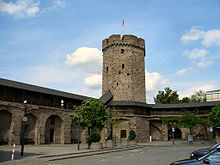
See also: List of cultural monuments in Lahnstein
Oberlahnstein
- Lahneck Castle
- Built around 1226 by the Elector of Mainz and Archbishop Siegfried II von Eppstein with a 29 m high pentagonal keep . Spornburg with knight's hall , castle chapel , castle kitchen, tower ascent, etc. Hourly guided tours through the castle from Easter to All Saints' Day. Castle restaurant. The Rheinhöhenweg , Lahnhöhenweg , Jakobsweg (Lahn-Camino from Wetzlar to Oberlahnstein and on to Kaub ) and Rheinsteig from Wiesbaden to Bonn cross here . For a number of years, the Lahnstein Municipal Stage hosted theater performances, the so-called Castle Festival , in the side courtyard of the castle.
- Martinsburg Castle
- Built in 1298 by the Electors of Mainz as a customs castle and part of the city fortifications. Rebuilt several times, numerous baroque elements. Today there are private apartments, a doctor's office, a minting workshop and a carnival museum .
- Youth culture center
- The youth culture center is a municipal institution that sees itself as an institution of youth cultural work and wants to be a socio-spatial reference point for young people. As a member of the LAG Soziokultur & Kulturpädagogik , the youth culture center is networked across Rhineland-Palatinate.
- city wall
- With Hexenturm (1324) (including the Lahnstein town museum) and the remains of a Franconian royal court (977) on Salhofplatz. Parts of the old Oberlahnstein city fortifications can also be found in many other places, e.g. B. in the Hintermauerrgasse, where a branch of the city museum is located in the town wall house built around 1700.
- Old Town Hall
- Very well preserved half-timbered building from the 15th century in Oberlahnstein. Until 2015 the seat of the city archive, which is now located in the building of the former Kaiser Wilhelm School on Kaiserplatz.
- Catholic parish church of St. Martin
- Late Romanesque towers around 1190, Gothic choir, baroque central nave, neo-Gothic side aisles; valuable Stumm organ from 1742–1744.
- St. James Hospital Chapel
- Romanesque Jacob's Chapel on the Way of St. James - excavations found the bones of a Santiago pilgrim here, and a scallop shell was added at hip level.
- Wenceslas Chapel
- Building from the 14th century, in which the Roman-German King Wenceslaus of Luxembourg was deposed on August 20, 1400 . The chapel had to give way to a railway line in 1903. In 1905 the choir was built nearby using the original material and provided with a vestibule.
- Protestant church
- Neo- Romanesque hall church from the years 1872–75, pointed helmet with Gothic corner branches, Romanesque arched portal
- limes
- The traces of the Roman border wall against the Teutons can still be found today over a length of 8 km in the Oberlahnstein city forest.
- outdoor pool
- At Lahneck Castle with a view of Stolzenfels Castle and the Rhine Valley.
- Lahnstein town hall
- Rare evidence of 1970s architecture in Rhineland-Palatinate, a listed building since 2007
Niederlahnstein
- John's Church and Monastery of the Congregation of the Sacred Heart of Jesus and Mary
- Church from 1130 ( Romanesque pillar basilica ) on the remains of an older church from the 10th century. The private St. Johannes-Gymnasium is connected . The remains of a Roman burgus can still be found here, which the Romans built in 369 AD at the mouth of the Lahn. It served to fortify the border and was a kind of guard for the Fort Confluentes ( Koblenz ).
- Nassau-Sporkenburger Hof, Lahnstein Municipal Stage
- Former Märkerhof from the 14th century. 1992–1997 rebuilt and refurbished, today the venue.
- Tavern on the Lahn
- Three-storey half-timbered building from 1697 with a customs tower from 1348. Johann Wolfgang von Goethe was a guest here on his Lahn tour on July 18, 1774, after he had written the poem Geistesgruß while looking at Lahneck Castle .
- All Saints Mountain Chapel
- Until 2012 the monastery of the Mission Society of the Huenfeld Oblates . Building from 1671. Neo-Gothic church from 1895. Place of pilgrimage .
- Parish Church of St. Barbara
- Rebuilt 1937–1939 by the architect Martin Weber . The 4.20-meter-high sandstone - Sculpture St. Barbara created in 1938 by the sculptor Otto Zirnbauer .
- Kindergarten Allerheiligenberg
- Built according to the designs of architect Heinz Bienefeld and Jan Thorn-Prikker . The building was presented in the 1996 Architecture Yearbook .
- Ruppertsklamm
- wild and romantic gorge, which is particularly appreciated by the hikers of the Rheinsteig
Friedrichssegen
- Friedrichssegen station
- Listed station building with storage shed made of clinker and half-timbered buildings. Construction began on November 6, 1883, and commissioned on May 20, 1884. The station building was constructed at the expense of the Friedrichssegen mine company . The single-storey extension was built around 1900.
- Friedrichssegen Mining Museum
- In 2000, the “Arbeitsgemeinschaft Grube Friedrichssegen ” opened the mining museum. Historical pit pictures (1905–1910) and more than 40 exhibits from Friedrichssegen minerals are exhibited here, including the so-called Emser Tönnchen .
- Friedrichssegen hydropower plant
- The power plant was built in 1906-07 to operate the Friedrichssegen mine. The three alternators from 1906 and the three Kaplan turbines from 1937 are still in operation today and generate an average of 4.8 kWh per year. The facility can be visited in the summer months.
Hiking trails
- The Rheinsteig , the new Rheinhöhenwanderweg from Bonn to Wiesbaden , crosses the Lahnstein area at the spa center and through the Ruppertsklamm. Oberlahnstein is connected to the Rheinsteig via the Burgenwanderweg via Lahneck Castle.
- The Rheinhöhenweg leads over Lahneck Castle and over the Lahn Bridge between Ober- and Niederlahnstein.
- The Lahnhöhenweg ends at Lahneck Castle.
- The Lahn-Camino , the Way of St. James from Wetzlar to Oberlahnstein, ends at the hospital chapel, from there it continues in the direction of Kaub on the Rhine-Camino .
- The Lahnwanderweg , awarded in 2010 by the Association of German Mountain and Hiking Associations with the seal of approval quality trail for hikers in Germany , ends in Lahnstein.
Sports
- Rhein-Lahn-Stadion in the Niederlahnstein district
- Type B arena with a large grass field, plastic circular track and other athletics facilities suitable for competitions, large tennis court, grass training ground.
- Municipal swimming pool
- At Lahneck Castle.
- volleyball
- The volleyball club Lahnstein-Friedrichssegen e. V. is the most successful and top-class gambling club in town. He plays with his first men's team in the Regionalliga Südwest. The mixed team took 8th place at the German championships in 2008. The VCL has particularly distinguished itself in recent years by organizing major events, such as various beach volleyball tournaments and the southern German championship in 2006 and the German championship in 2008 in mixed volleyball.
- rowing
- The rowing company Lahnstein 1922 e. V. is the local rowing club in Lahnstein.
- Soccer
- After the dissolution of the SG Eintracht Lahnstein club, a new soccer club was founded, the FSV Rot-Weiß Lahnstein.
- swim
- In Niederlahnstein there is a swimming pool where various clubs train.
- Sports club
- Turngemeinde 1878 eV Oberlahnstein with more than 1,330 members. Gymnasium and 2 club halls (gym and multi-purpose hall), club room (former restaurant)
Regular events
- Rhine in Flames
- Large fireworks and ship convoy on the second Saturday in August along Spay , Braubach with Marksburg , Brey , Rhens , Koblenz-Stolzenfels with Stolzenfels Castle , Lahnstein with Lahneck Castle and the mouth of the Lahn to the fireworks display from Ehrenbreitstein Fortress in Koblenz .
- Lahneck Live
- Cultural festival formerly at the mouth of the Lahn (Niederlahnstein). The festival always takes place on the last weekend in May (Friday – Sunday) in the Rheinanlagen in the Oberlahnstein district and is linked to the Rhineland-Palatinate cultural summer. Entry is free!
- Lahnstein municipal stage
- Castle Festival
- The Lahnsteiner Burgfestspiele are the oldest open-air plays in Rhineland-Palatinate. After Lahneck Castle and Salhofplatz had previously served as a venue, they have been taking place in summer on an open-air stage in front of the Johanniskirche in Niederlahnstein since 2017 .
- Lehner fair
- Always on the first weekend in September in Niederlahnstein
- Oberlahnsteiner fair with city festival
- Always on the second weekend in September
- Rose Monday parade
- In Oberlahnstein
- Cap trip on Shrove Tuesday
- In Niederlahnstein
- Children's and young people's parade on Shrove Tuesday
- From Nieder- to Oberlahnstein
- Lahnsteiner two rivers run
- Fun run on the first Friday in June along the Rhine and Lahn.
- Rhineland-Palatinate Championships in Guard Dance
- For children and juniors in the town hall, every 3rd Saturday in September.
- Lahnsteiner Blues Festival
- Annually in autumn, since 1981 as SWF-, from 1998 to 2005 as SWR-Blues-Festival with the exception of 2001.
Economy and Infrastructure
Companies

education
- Elementary schools
- Realschulen and Realschule plus
- Realschule Lahnstein in Oberlahnstein
- Special schools
- Freiherr vom Stein School in Oberlahnstein
- High schools
- Marion-Dönhoff -Gymnasium in Oberlahnstein (formerly: Staatliches Neusprachliches Gymnasium Oberlahnstein)
- Private Johannes-Gymnasium Lahnstein in Niederlahnstein
- Vocational schools
- Vocational School (BBS) in Oberlahnstein
- Adult education centers
- VHS Lahnstein
traffic
- Rail transport
- The RB 10 trains operated by VIAS Verkehrsgesellschaft operate on the right-hand Rhine route from Frankfurt Hbf via Frankfurt-Höchst, Wiesbaden Hbf, St. Goarshausen, Koblenz Hbf and Koblenz Stadtmitte to Neuwied.
- Oberlahnstein station and Niederlahnstein station on the Cologne – Wiesbaden railway line
- On the Lahntalbahn , via which Lahnstein is connected by the Niederlahnstein and Friedrichssegen stations , the trains of the RB 23 line of Deutsche Bahn AG run under the name Lahn-Eifel-Bahn from Limburg (Lahn) via Diez, Bad Ems, Koblenz Hbf, Koblenz City center, Andernach and Mendig to Mayen East.
- The RE25 (Lahntalexpress) operated by DB Regio, which runs from Koblenz Hbf via Niederlahnstein, Bad Ems, Diez, Limburg (Lahn), Weilburg and Wetzlar to Gießen, also stops at Niederlahnstein train station.
- Road traffic
- Via the B 42 on the right bank of the Rhine and via the B 260 (called: the Bäderstraße ) to Bad Ems and Nassau to Niederwalluf near Wiesbaden.
- Bridges: The Lahn cross the Lahntal Bridge (B 42), the Rudi-Geil Bridge (L 335) between Ober- and Niederlahnstein, the Lahn Bridge Friedrichssegen and two railway bridges.
- Cologne-Düsseldorf Rhine ships dock in Oberlahnstein in the Rhine facilities.
Others
Personalities
sons and daughters of the town
- Franz Emmerich Kaspar Waldbott von Bassenheim (1626–1683), Roman Catholic Bishop of Worms
- Nikolaus Weinbach († 1658), 1633–1642 abbot at Eberbach Monastery
- Wilhelm Lanz (1829–1882), First Mayor of Wiesbaden from 1868 to 1882
- Caspar Weis (1849–1930), neo-Gothic artist
- Hugo Rheinhold (1853–1900), German sculptor
- Otto Rheinhold (1855–1937), manufacturer, founder and patron
- Otto Mandt (1858–1919), Rear Admiral and Privy Councilor
- Anton Dahlem (1859–1935), member of the German Reichstag
- Otto Stadelmann (1874–1952), lawyer
- Fritz Michel (1877–1966), doctor, politician, historian and art historian
- Walther Karl Zülch (1883–1966), art historian
- Ernst Biesten (1884–1953), lawyer
- Hermann Beckby (1890–1980), philologist and local historian
- Hans Bohn (1891–1980), graphic artist
- Grit Hegesa (1891–1972), dancer and actress
- Julius Liebrecht (1891–1974), entrepreneur at Boehringer Ingelheim
- Wilhelm Christian Crecelius (1898–1979), medic
- Franz Josef Geil (1907–1948), politician (CDU), Member of the State Parliament, Mayor of Lahnstein
- Carl Vath (1909–1974), businessman and Roman Catholic prelate as well as President Caritas Internationalis
- Bernhard Plettner (1914–1997), engineer, CEO of Siemens AG
- Herbert Walther (1922–2003), non-fiction author, painter and graphic artist
- Heinrich Fisch (1925–2008), educator and social scientist
- Maria Hugonis Schäfer (1930–2014), religious sister and educator
- Walter Benz (1931–2017), mathematician
- Willibald Hilf (1931–2004), politician (CDU), Member of the Bundestag, director of Südwestfunk
- Peter Huttenlocher (1931–2013), neuropaediatrist and neuroscientist
- Rudi Geil (1937-2006), politician (CDU), MdL
- Heribert Meffert (* 1937), professor of business administration
- Gottfried Pott (* 1939), professor of calligraphy
- Peter Lauch , pop singer
- Axel Heibel (* 1943), object artist
- Gunter Runkel (* 1946), sociologist and sexologist
- Jürgen Wöhler (* 1950), lawyer
- Dieter Portugall (* 1952), artist
- Margot Nienkämper (* 1953), politician (CDU)
- Gabriele Leupold (* 1954), translator
- Nikolaus Heidelbach (* 1955), graphic artist, picture book illustrator and author
- Dagmar Leupold (* 1955), writer
- Eduard Zwierlein (* 1957), philosopher and professor of philosophy at the University of Koblenz-Landau
- Thorsten Becker (* 1958), writer
- Michael Born (1958–2019), television journalist and " Kujau des Fernsehens"
- Manuela Grochowiak-Schmieding (* 1959), politician, member of the state parliament of North Rhine-Westphalia
- Michael Hohl (* 1959), politician (CSU), Lord Mayor of the City of Bayreuth (2006-12)
- Karl Ulrich Bartz-Schmidt (* 1960), specialist in ophthalmology
- Roger Lewentz (* 1963), politician (SPD)
- Axel Wilke (* 1963), politician (CDU), MdL
- Ralf Becker (* 1975), Professor of Philosophy at the University of Koblenz-Landau
- Daniel Bahr (* 1976), politician (FDP)
- Timo Scheider (* 1978), automobile racing driver
- Stefanie Löhr (* 1979), soccer player
- Stefan Feth (* 1980), table tennis player
- Markus Fachbach (* 1982), triathlete
- Annika Olbrich (* 1985), actress
- Philipp Langen (* 1986), soccer player
- Oliver Laux (* 1990), football player
- Carl Bruchhäuser (* 1991), actor
- Clara Louise , b. Clara Güll (* 1992), singer-songwriter
People associated with the city
- Anton Abt (1841–1895), theologian and writer, founded the Higher Citizens School in Oberlahnstein in 1873, from which the grammar school emerged
- Nikolai von Astudin (1847–1925), Russian landscape painter, lived and died in Oberlahnstein in the 1920s.
- Robert Bodewig (1857–1923), Professor Dr., history teacher in Lahnstein, local history researcher, archaeological autodidact
- Mariano Freiherr von Droste zu Hülshoff (1907–1997), chief forest master, lived in Lahnstein for several years
- Max Otto Bruker (1909–2001), doctor and author, 1977–1991 head of the Lahnhöhe Clinic. The Bruker House in Lahnstein has existed since 1994.
- Idilia Dubb , an English tourist, is said to have starved to death in the keep of Lahneck Castle in 1851.
- Ernst Fuhrmann (1886–1956), writer, founded Folkwang-Auriga Verlag in 1928 in Jungfried's house
- Johann Philipp Holzmann (1805–1870), building contractor and founding father of Philipp Holzmann AG , built the port in Oberlahnstein in 1860
- Joe Juhnke (1925–2016), writer and restaurateur
- Richard Ott (1928–2008), religious priest, philologist and teacher at the Johannes-Gymnasium
- Rudolf Scharping (* 1947 in Niederelbert, Westerwald) temporarily resided in Lahnstein and member of the city council, from 1991 to 1994 Prime Minister of the State of Rhineland-Palatinate and from 1998 to 2002 Federal Minister of Defense
- Manfred Schneider (1953–2008), composer, arranger and conductor, lived in Lahnstein
- Anton Schütz (1861–1919), politician, former mayor of Oberlahnstein
- Hubertus Seibert (* 1954 in Koblenz), historian of medieval history at the University of Munich , author and editor of the Lahnstein city chronicle
- Emil Simonis (1928–2010), master butcher and founding member of NTG
- Martin Weber (1890–1941), architect, builder of the parish church of St. Barbara in Niederlahnstein
- Walter Weber (1886–1966), Mayor of Oberlahnstein (1920–1933) and District Administrator of the Main-Taunus District (1945–1946)
- Klaus Weinand (born December 14, 1940 in Koblenz), German national basketball player in the 1960s and early 1970s, ophthalmologist in Lahnstein
- Georg Zülch (1851–1890), local history researcher, founder of the Lahnsteiner Altertumsverein
Honorary citizen
- Rudi Geil (1937–2006), former Minister of the Interior in Rhineland-Palatinate and Mecklenburg-Western Pomerania , awarded in November 2005
- Fritz Michel (1877–1966), doctor and historian, awarded in 1954 in Niederlahnstein and 1961 in Oberlahnstein
- Walter Weber (1886–1966), Mayor of Oberlahnstein (1920–1934) and District Administrator of the Main-Taunus District (1945–1946), made an honorary citizen of Lahnstein in 1962, and in 1963, Dr.-Weber-Strasse was named after him in Oberlahnstein named
literature
- Oberlahnstein: a guide through town and surroundings , ed. from the traffic and beautification association Oberlahnstein, Oberlahnstein 1910. Digitized
- Fritz Michel : History of the City of Niederlahnstein. City of Niederlahnstein (ed.), Niederlahnstein 1954.
- Fritz Michel: History of the city of Lahnstein. Continued by Peter Bucher. Edited by Franz-Josef Heyen on behalf of the city of Lahnstein. Lahnstein 1982.
- Willi Eisenbarth: Historic sites and sights in Lahnstein. A Lahnstein city guide. Ed .: City administration Lahnstein. 2nd Edition. Lahnstein 1994.
- Hubertus Seibert (Hrsg.): From the electoral town to the large town belonging to the district - the history of Lahnstein in the 19th and 20th centuries, Lahnstein 1999.
- Lahnstein in old views. Edited on behalf of the city of Lahnstein. Texts and pictures compiled by city archivist Bernd Geil. 2nd edition Lahnstein 2007. ISBN 3-9810505-3-3 .
- Lahnstein then and now. Edited on behalf of the city of Lahnstein. Texts and pictures compiled by city archivist Bernd Geil. Lahnstein 2009. ISBN 978-3-9810505-9-2 .
Web links
Individual evidence
- ↑ State Statistical Office of Rhineland-Palatinate - population status 2019, districts, communities, association communities ( help on this ).
- ↑ State Statistical Office Rhineland-Palatinate (ed.): Official directory of the municipalities and parts of the municipality. Status: January 2019 [ Version 2020 is available. ] . S. 63 (PDF; 3 MB).
- ↑ Official municipality directory (= State Statistical Office of Rhineland-Palatinate [Hrsg.]: Statistical volumes . Volume 407 ). Bad Ems February 2016, p. 169 (PDF; 2.8 MB).
- ↑ 20 years ago: Lahnstein auf der Höhe becomes a “place with a mineral spring spa”. ( Memento from July 10, 2018 in the Internet Archive ) Homepage City of Lahnstein.
- ^ The Regional Returning Officer Rhineland-Palatinate: Municipal Council Election 2019 Lahnstein, non-association municipality. Retrieved November 2, 2019 .
- ^ City of Lahnstein: Result of the Mayor election Lahnstein 2013. Accessed on November 2, 2019 .
- ↑ 50 years ago Lahnstein received a new city coat of arms. In: Website Lahnstein. Retrieved February 28, 2020 .
- ↑ Lahnstein City Archives
- ↑ Evangelical Church Oberlahnstein at regionalgeschichte.net accessed on June 27, 2018
- ^ Chronicle of the mining village Friedrichssegen ( Memento from February 28, 2012 in the Internet Archive ) on Rhein-Lahn-Info.
- ↑ Friedrichssegen Mining Museum Official homepage.
- ^ Castle Festival on the website of the city of Lahnstein
- ↑ The Lahnsteiner Burgspiele 2018
- ^ Entry on Ernst Fuhrmann in the Rhineland-Palatinate personal database , accessed on March 18, 2017 .
- ↑ 50 years ago the doctor and scientist Dr. Dr. hc Fritz Michel, accessed on July 10, 2018
- ↑ Entry on Walter Weber in the Rhineland-Palatinate personal database , accessed on February 7, 2017 .

